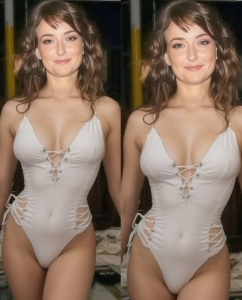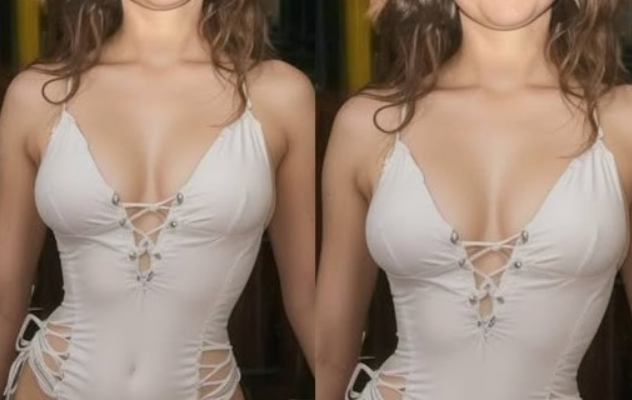
“The White Swimsuit”
She hadn’t worn it in years.
Folded neatly in the back of her drawer, behind the scarves and the silk blouses she no longer wore, the white swimsuit waited. It was the kind with lace-up sides and a front that dipped just enough to feel daring, but not enough to feel exposed. She had bought it on a whim in her twenties, during a solo trip to Kep, when the sea had felt like a secret and her body had felt like a promise.
Now, at forty-two, she wasn’t sure what her body felt like.
It wasn’t shame. Not exactly. More like distance. Like she had been living beside herself for years—watching, managing, surviving—but rarely arriving.
Her name was Mara.
She lived in a quiet house in Siem Reap, not far from the river. Her days were filled with small tasks: watering the orchids, preparing rice for her father, teaching English to children who giggled at her accent. She was good at routines. Good at disappearing into them.
But something had shifted.
It began with a photograph.
Her niece, Dara, had taken it during a family gathering. Mara hadn’t noticed the camera. She was laughing—head tilted back, eyes closed, hair falling in waves over her shoulders. When Dara showed her the image, Mara stared at it for a long time.
“I look… happy,” she said.
“You look like you,” Dara replied.
That night, Mara opened the drawer. She touched the swimsuit gently, as if it might crumble. It still smelled faintly of salt and coconut oil. She held it against her chest and closed her eyes.
The next morning, she put it on.
The mirror didn’t lie.
There were stretch marks now. Softness where there had once been tautness. Her collarbones were less pronounced. Her thighs touched.
But her smile—her smile was the same.
She stood in the center of the room, sunlight pouring in through the slatted windows. The tiled floor was cool beneath her feet. She turned slowly, letting the light catch the curves of her body, the texture of the lace, the quiet strength in her posture.
She wasn’t trying to be beautiful.
She was trying to be present.
She took a photo.
Not for anyone else. Just for herself. A record. A ritual.
She placed the camera on a stool, set the timer, and stood by the vertical poles near the window. She smiled—not the practiced smile of politeness, but the real one. The one that came from remembering who she was.
Click.
She looked at the image.
Two versions of herself, side by side. Identical, yet different. One from memory. One from now.
She saw the woman she had been—the one who had danced barefoot on the beach, who had kissed a stranger under a monsoon sky, who had written poems on napkins and tucked them into her bra.
And she saw the woman she was—the one who had buried a mother, who had held her father’s hand through illness, who had taught children how to say “hope” in two languages.
Both were real.
Both were hers.
Later that day, she walked to the river.
She wore a loose sarong over the swimsuit, her hair tied back with a ribbon. She sat on the edge of the dock, feet dangling above the water, and watched the boats drift by.
An older woman passed by and nodded. “You look radiant,” she said.
Mara smiled. “I feel… awake.”
The woman sat beside her. They didn’t speak for a while. Just watched the water.
Then the woman said, “I used to wear red lipstick every day. Even when I had nowhere to go. It reminded me I was still here.”
Mara nodded. “This swimsuit does that for me.”
They laughed softly. Two strangers, sharing a moment.
That evening, Mara printed the photo.
She placed it on her dresser, beside a small bowl of jasmine petals and a candle she lit each night. It wasn’t vanity. It was remembrance.
Each time she saw it, she whispered: “You are still here.”
Weeks passed.
Mara wore the swimsuit again. Not every day. Just when she needed to remember. She wore it while sweeping the floor, while reading poetry, while dancing alone to old Khmer songs.
She began writing again.
Small things. Observations. Fragments.
“The body is not a battlefield. It is a garden. It blooms differently each season.”
“I am not what I used to be. I am what I survived.”
“The lace holds me together. Not because it hides me, but because it honors me.”
She shared one with Dara, who cried.
“You should publish these,” Dara said.
“Maybe,” Mara replied. “But for now, they’re just for me.”
One morning, a young woman knocked on her door.
She was a neighbor, new to the area. She had heard Mara taught English. She wanted to learn.
Mara invited her in.
The woman hesitated. “I’m not very confident,” she said. “I feel… invisible.”
Mara smiled. “Then let’s start with visibility.”
She handed her a notebook.
“Write one thing each day that reminds you you’re real.”
The woman nodded.
And so, the lessons began.
Mara never became famous.
She never posted the photo online. Never turned her writings into a book. But she became something else—something quieter, deeper.
She became a mirror.
For every woman who had forgotten. For every girl who had doubted. For every person who had stood in front of a reflection and wondered if they were enough.
She showed them: you are.
And the white swimsuit?
It faded over time. The lace frayed. The straps loosened.
But Mara kept it.
Not as a relic.
As a reminder.
That presence is not about perfection.
It’s about showing up.

